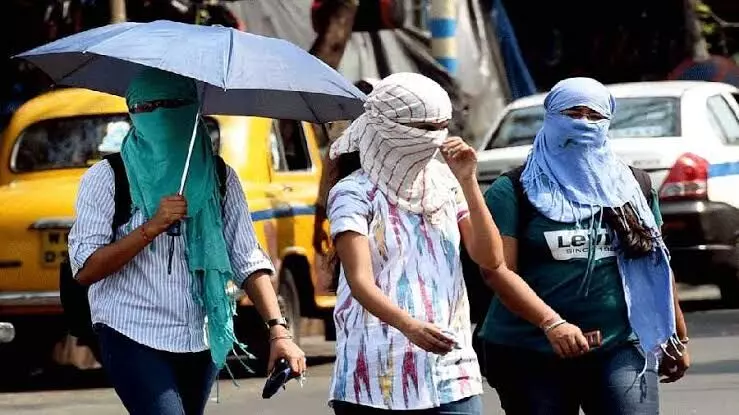Hyderabad Heatwave: IMD predicts brief respite from heat from May 4
IMD scientist Soma Sen anticipates relief for citizens from May 4 onwards, with a slight reduction in temperatures expected
By Anoushka Caroline Williams
Hyderabad: Even as Hyderabad and the rest of Telangana are passing through another scorching summer, there’s a glimmer of hope on the horizon.
IMD scientist Soma Sen anticipates relief for citizens from May 4 onwards, with a slight reduction in temperatures expected.
This forecast comes amid contrasting tales of Hyderabad’s summers in 2023 and 2024, highlighting the volatile nature of India’s climate.
Here’s an overview of the climate and weather conditions in 2023 and 2024.
Heatwave in June 2023
In June 2023, while much of the country experienced uncharacteristically cool temperatures, eastern India faced a contrasting scenario with an increase in heat wave occurrences. This deviation from the norm was primarily attributed to active thunderstorm activity and the frequent passage of western disturbances over northern India, complemented by other synoptic-scale weather systems over central and Peninsular India.
The impact of this heat wave was particularly felt in regions across West Bengal, Odisha, Bihar, eastern Uttar Pradesh, Jharkhand, Chhattisgarh, coastal Andhra Pradesh, and Telangana. These areas witnessed a significant rise in the number of extreme heat days, ranging from 11 to 19 days, compared to the usual two to four days.
Additionally, parts of central India, including eastern Madhya Pradesh and Maharashtra’s Vidarbha, experienced seven to nine days of heatwave conditions.
The severity of the heat wave varied across regions, with Bihar enduring heat wave to severe heat wave conditions for nearly the entire duration from June 1 to 22.
Similarly, West Bengal experienced such conditions from June 1 to 18, while eastern Uttar Pradesh encountered them from June 12 to 21.
Intensifying Heat Wave: April 2024
As of April 30, temperatures have already surged above 45 degrees Celsius in April, signalling a brutal start to the season.
Dr Shravani, an IMD scientist, attributes this year’s harsh conditions to a steady influx of dry south-easterly winds, driven by an anticyclone. The absence of moisture in the air, coupled with changing climate patterns, exacerbates the perception of heat.
As the mercury soared to a scorching 46 degrees Celsius, some regions of India grappled with severe heatwave conditions, according to the India Meteorological Department (IMD). This marked the second occurrence of such intensity within the current season, signifying an alarming escalation.
Regional Impact: The eastern regions of India bore the brunt of the prevailing heatwave, with Odisha and West Bengal experiencing severe conditions. Additionally, Chhattisgarh, Bihar, Jharkhand, and Tamil Nadu also witnessed heatwave conditions on specific dates. Telangana and Saurashtra & Kutch encountered heatwave conditions during certain periods, further exacerbating the situation.
Onset and Duration: The onset of the heatwave conditions in Odisha commenced on April 15, followed by Gangetic West Bengal on April 17. The severity of the situation peaked on April 21, 2024, when Bharagora in East Singhbhum district, Jharkhand, recorded the highest maximum temperature of 46°C.
Regional Temperature Trends
According to the IMD forecast for the week ending May 1 maximum temperatures soared across various regions of India.
In Rayalaseema, Coastal Andhra Pradesh and Yanam, Telangana, Odisha, and Gangetic West Bengal, temperatures ranged between 42-44°C.
Similar conditions were observed in isolated pockets of Tamil Nadu, Puducherry, Karaikal, and Jharkhand. Moreover, temperatures ranged from 40-42°C in many parts of Bihar, East Uttar Pradesh, with isolated pockets experiencing similar conditions in Gujarat and other areas.
Additionally, several regions, including West Bengal and Sikkim, Bihar, Jharkhand, Assam and Meghalaya, witnessed maximum temperatures notably above normal by 3-5°C.
Temperature Expectations: The IMD anticipates a fluctuation in maximum temperatures over the next two days across different parts of India.
A rise of about 2°C is expected in many parts of Northwest India, followed by a subsequent fall of 2-3°C for the following three days.
Thereafter, a rise of 2-4°C is predicted. Similarly, a rise of 2-3°C in maximum temperatures is forecasted over east India and Maharashtra during the first half of the week, with minimal change expected thereafter.
Conversely, minimal alterations in maximum temperatures are anticipated across the rest of the country throughout most days of the week.
India’s weather outlook
Beyond Hyderabad, the IMD’s forecast issues a warning for the entire country. Mrutyunjay Mohapatra, director general of IMD, cautions of above-normal temperatures and intensified heatwaves, particularly in regions like Gujarat and Maharashtra.
While El Niño conditions persist, offering little respite, there’s a glimmer of hope with a projected transition to La Niña later in the year.
As India confronts the looming spectre of a scorching summer, adapting to evolving climate patterns becomes imperative. The IMD’s focus on enhanced forecasting techniques underscores the importance of preparedness. While challenges loom, including the urban heat island effect, proactive measures and awareness can mitigate the impacts of extreme weather events.